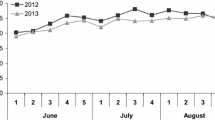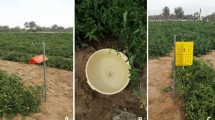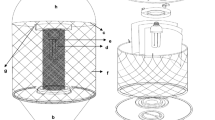Abstract
The tomato moth, Tuta absoluta (Meyrick, 1917) (Lepidoptera: Gelechiidae), is one of the most damaging pests of tomato crop in Turkey and is of great economic importance in greenhouse-grown tomatoes. Current control of this pest has heavily relied on the use of synthetic insecticides, inducing the selection of resistant T. absoluta populations and negative environmental impact. In this study, the efficacy of mass trapping using a new-designed light trap (so-called ecosav-D1) in reducing leaf and fruit damages in greenhouse-grown tomatoes was investigated in Antalya (in southwest Turkey). Trials were carried out in commercial plastic greenhouses equipped with insect-proof nets in both autumn–winter and summer–autumn tomato growing seasons in 2019 and 2020. In each season, the study greenhouse was divided into two equal plots using anti-insect net (40 mesh); in one of them, the new-designed light trap was tested at a density of 1 trap/250 m2, and in the other one, conventional control system, based largely on the use of synthetic pesticides, was implemented for comparison. In the light trap plot, total number of adult T. absoluta, other pests and beneficial insects caught per trap was recorded weekly. The efficacy of mass trapping in reducing leaf and fruit damages was evaluated by comparing weekly damage on leaves (number of larval mines on 1 leaf per plant on 50 randomly chosen plants) and percentages of damaged fruits in each harvest date in both plots. Results showed that mass trapping of adult T. absoluta using the new-designed light trap was effective in reducing leaf and fruit damages at low/moderate T. absoluta population density in autumn–winter growing season. Considering the seasonal averages, significantly lower leaf and fruit damages were observed in the light trap plot (3.2 larval mines/leaf/plant and a fruit damage of 13.4%) than in the conventional plot (6.9 mines/leaf/plant and 18.3%, respectively). On the other hand, although the light trap significantly reduced leaf and fruit damages during the summer–autumn growing season, it was partially ineffective when the pest density soared at the end of the tomato cultivation. In both growing periods, higher densities of tomato moth resulting in much more leaf and fruit damages were observed in the conventional plot, compared with the trap plot. Overall results suggest that the new-designed light trap can be an effective tool for the integrated pest management (IPM) of this pest in greenhouse tomato cultivation.




Similar content being viewed by others
Availability of data and materials
All data are within the manuscript and supplementary materials.
Code availability
Not applicable.
References
AKIB/MEU (Mediterranean Exporter Unions) (2017) Export figures of 2016. http://www.akib.org.tr. Accessed 17 January 2021
Bayram Y, Bekta Ö, Büyük M, Bayram N, Duman M, Mutlu Ç (2014) A survey of tomato leafminer [(Tuta absoluta Meyrick) (Lepidoptera: Gelechiidae)] and its natural enemies in the Southeast Anatolia Region. Turk J Biol Cont 5(2):99–110
Bayram Y, Duman M, Buyuk M, Mutlu Ç (2017) Efficiency of pheromone water traps and life cycle of Tuta absoluta (Lepidoptera: Gelechiidae) in Diyarbakir province. Turkey Fresen Environl Bull 26(12A):8146–8153
Caparros-Megido R, Brostaux Y, Haubruge E, Verheggen FJ (2013) Propensity of the tomato leafminer, Tuta absoluta (Lepidoptera: Gelechiidae), to develop on four potato plant varieties. Am J Pot Res 90:255–260
Cocco A, Deliperi S, Delrio G (2012) Potential of mass trapping for Tuta absoluta management in greenhouse tomato crops using light and pheromone traps. Integrated Control in Protected Crops, Mediterranean Climate. IOBC-WPRS Bull 80:319–324
Çekin D, Yaşar B (2015) The life table of Tuta absoluta (Meyrick, 1917) (Lepidoptera: Gelechiidae) on different tomato varieties. J Agr Sci 21:199–206
Desneux N, Wajnberg E, Wyckhuys KAG, Burgio G, Arpaia S, Narvaez-Vasquez CA, Gonzalez-Cabrera J, Ruescas DC, Tabone E, Frandon J, Pizzol J, Pon-cet C, Cabello T, Urbaneja A (2010) Bio-logical invasion of European tomato crops by Tuta absoluta: Ecology, geographic expansion and prospects for biological control. J Pest Sci 83:197–215
Erler F, Can M, Erdoğan M, Ateş AÖ, Pradier T (2010) New record of Tuta absoluta (Meyrick) (Lepidoptera: Gelechiidae) on greenhouse-grown tomato in southwestern Turkey (Antalya). J Entomol Sci 45:392–393
Erler F, Kirisik M, Topuz E (2020) Comparable study on different colored sticky traps for catching of adult Tuta absoluta (meyrick) (Lepidoptera: Gelechiidae). Fresen Environ Bull 29(9):7349–7354
Gahramanova G, Mamay M (2020) Population development and infestation rate of Tomato Leafminer [Tuta absoluta (Meyrick, 1917) (Lepidoptera: Gelechiidae)] in tomato and eggplant greenhouses in Absheron region of Azerbaijan. Harr Tar Gıda Bil Derg (Harr J Agri Food Sci) 24(4):372–380
Guedes RNC, Picanço M (2012) The tomato borer Tuta absoluta in South America: Pest status, management and insecticide resistance. Bull OEPP/EPPO Bull 42(2):211–216
Han P, BayramY S-H et al (2019) Tuta absoluta continues to disperse in Asia: damage, ongoing management and future challenges. J Pest Sci 92:1317–1327
Kılıç T (2010) First record of Tuta absoluta in Turkey. Phytoparasitica 8:243–244
Laore S (2010) Tomato moth, Tuta absoluta (Meyrick, 1917), Povolny (1994) Recognition and management. Cagliari, Italy: Laore, Regional Agency for Agricultural Development. http://www.sardegnaagricoltura.it/documenti/14_43_20100420134239.pdf. Accessed 21 January 2021 (in Italian)
Lietti MMM, Botto E, Alzogaray RA (2005) Insecticide resistance in Argentine populations of Tuta absoluta (Meyrick) (Lepidop-tera: Gelechiidae). Neotrop Entomol 34:113–119
Mamay M, Yanık E (2012) Determination of adult population development of Tomato leafminer [Tuta absoluta (Meyrick) (Lepidoptera: Gelechiidae)] in tomato growing areas in Şanlıurfa. Turk Bull Entomol 2(3):189–198
Sannino L, Espinosa B (2010) Tuta absoluta, Guida alla conoscenza e recenti acquisizioni per una corretta difesa. L’Informatore Agrario 66(46) Supplement 1:1–113 (in Italian)
SAS (2001) User’s Guide: Statistics, Version 8.2. SAS Institute, NC, USA.
Siqueira HÁA, Guedes RNC, Picanço MC (2000) Insecticide resistance in populations of Tuta absoluta (Lepidoptera: Gelechiidae). Agric Forest Entomol 2:147–153
Sridhar V, Kumaran GS (2018) Light trap, an effective component of integrated management of Tuta absoluta (Lepidoptera: Gelechiidae) on tomato. J Hort Sci 13(1):126–128
TUIK (2020) Crop Production Statistics 2018–2019. http://www.tuikapp.tuik.gov.tr/bitkiseluretim. Accessed 22 January 2021
Uchôa-Fernandes MA, Vilela EF (1994) Field trapping of the tomato worm Scrobipalpula absoluta (Meyrick) (Lep., Gelechiidae). Ann Soc Entomol Bras 23:271–277
Unlu L (2012) Potato: A new host plant of Tuta absoluta Povolny (Lepidoptera: Gelechiidae) in Turkey. Pak J Zool 44:1183–1184
Urbaneja A, González-Cabrera J, Arnó J, Gabarra R (2012) Prospects for the biological control of Tuta absoluta in tomatoes of the Mediterranean Basin. Pest Manag Sci 68(9):1215–1222
Acknowledgements
The authors thank KEKOVA Energy, Agriculture, Industry and Trade Ltd. Co. (Etiler, Evliya Çelebi Cd. No: 7/F, 07010 Muratpaşa/Antalya, Turkey) for providing light traps and the greenhouse owners for their helps in providing study area.
Funding
Not applicable.
Author information
Authors and Affiliations
Corresponding author
Ethics declarations
Conflict of interest
The authors declare that they have no conflict of interest.
Consent for publication
Not applicable.
Ethics approval and consent to participate
Not applicable.
Additional information
Publisher's Note
Springer Nature remains neutral with regard to jurisdictional claims in published maps and institutional affiliations.
Rights and permissions
About this article
Cite this article
Erler, F., Bayram, Y. Efficacy of mass trapping of tomato moth, Tuta absoluta (Meyrick, 1917) (Lepidoptera: Gelechiidae), using a new-designed light trap in reducing leaf and fruit damages in greenhouse-grown tomatoes. J Plant Dis Prot 128, 1177–1185 (2021). https://doi.org/10.1007/s41348-021-00473-8
Received:
Accepted:
Published:
Issue Date:
DOI: https://doi.org/10.1007/s41348-021-00473-8




